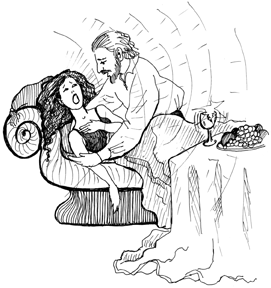Shattering: Don't sit so close to me

DRAWING BY DEBORAH DERR McCLINTOCK
Q. The soprano lies on her deathbed as the performance is nearing its end. She reaches the climactic moment in the music and belts her final, shrill and magnificent high note. Should the opera connoisseur in the third row worry about her glasses shattering? How about in the balcony?– G. Verdi
A. What kind of glasses? The old Ella Fitzgerald TV ad demo probably used a crystal-glass wine goblet and a very loud sustained note (maybe even amplified) to cause the shattering. The secret here is to match the frequency of the note to a natural resonant frequency of the glass, then to keep pumping in singing energy for a couple of seconds as vibrational energy builds, at fairly close range, says Kettering University physicist Dan Ludwigsen. So forget the balcony or even the third row back. There is little area to the lenses for the sound pressure to cause deformation.
"I would guess that the prop eyeglasses worn by the tenor right next to the soprano would also be safe. A wineglass on the table might not fare as well," Ludwigsen says.
The difference here is the wineglass has distinct resonances based on its shape, audible as a clear ring when you tap the glass, like a tuning fork that has been rotated into a bowl shape. There is no such ring with lenses. There was a vocalist on TV's Mythbusters who could shatter a wineglass, but only if it was within an inch or two of his face. "The vocalist's sound reached 105 dB, like a jackhammer at the operator's position," says the physicist.
Q. It's found in both over-the-counter and prescription medications, used to relieve or prevent asthma, treat migraines, increase blood pressure, as a diuretic, and much more. Yet it has been studied for possible negative side effects relating to cancer, heart disease, ulcers, osteoporosis, PMS, infertility, hyperactivity and mental dysfunction, though so far no clear linkage to any of these has been proven for its moderate use. It's undeniably toxic if taken in too-large quantities, but with a typical dose being from 80-180 mg, you would need to consume 55-125 of these doses all at one time to reach a fatal threshold. What is this oft-imbibed chemical, unregulated and readily available almost everywhere in the world as part of society's daily wakeup call? –J. Valdez
A. Caffeine– one of the most studied drugs in the world, say Penny Le Couteur and Jay Burreson in Napoleon's Buttons: 17 Molecules that Changed History.
Q. Late at night you're haunted by a melody that keeps running through your head. You can't sleep. Who might you call at this hour to help identify the music and put your mind to rest? –B. Gates
A. Just boot up your computer and head for the Melodyhound website, then start humming or even whistling the melody. Or if you're not audio equipped, use the Parson's code: Here, explains Richard Dawkins in The Ancestor's Tale, you just hum the tune and turn it into a series of ups (U's) and downs (D's).
The first note is ignored, because obviously it can be neither up nor down. Imagine then on this insomniac night you type into the Melodyhound website: UUUDUUDDDDDUUUUUDDDUD. Amazingly, the online computer correctly sleuthed this fragment of a favorite tune as coming from the "Londonderry Air"– calling it "Danny Boy," the name by which Americans know it because of some 20th-century words set to it.
"At first it seems surprising that a tune could be identified by such a short sequence of symbols, telling only the direction of movement, not the distance, and with no indication of durations of notes. But it really works," they say.
Q. If you really want your body to last after death, what's your best bet? –T. Williams
A. Bodies have survived for centuries in relatively good condition under circumstances where they were initially disinfected, as with embalming or soaking in alcohol, kept away from insects or animals, and sealed in an airtight casket, says Kenneth Iserson in Death to Dust.
But truly airtight is hard to achieve, say scientists who search for "pure ancient air" in old sealed caskets. A better bet– unless you can get yourself frozen deep inside a glacier– is to have your body embalmed and then embedded in a block of plastic. This should work wonders.
The danger is that it may work too well. Many specimens not nearly this well preserved are on display in museums, which is where you may wind up centuries hence. "Perhaps this method should only be tried by the ultimate exhibitionist," says Iserson.
Send Strange questions to brothers Bill and Rich at .